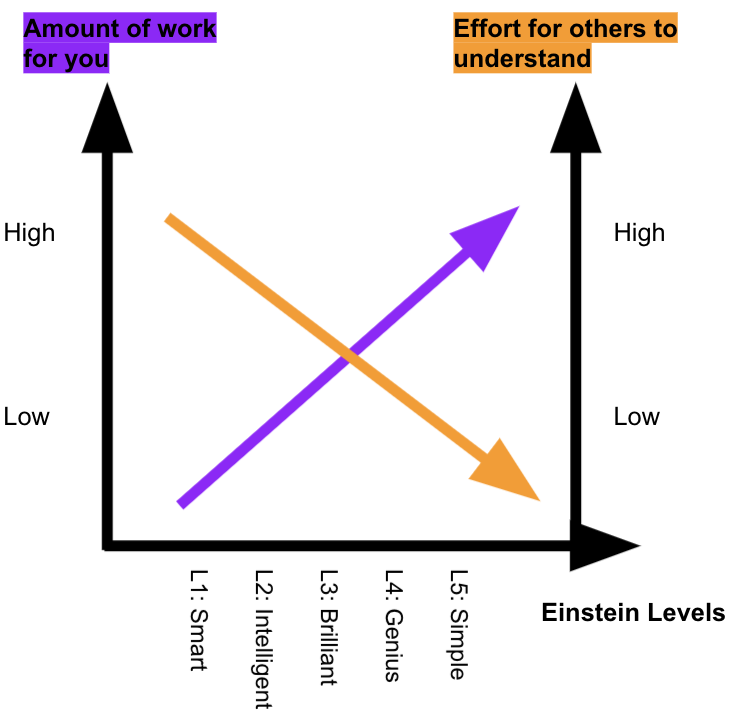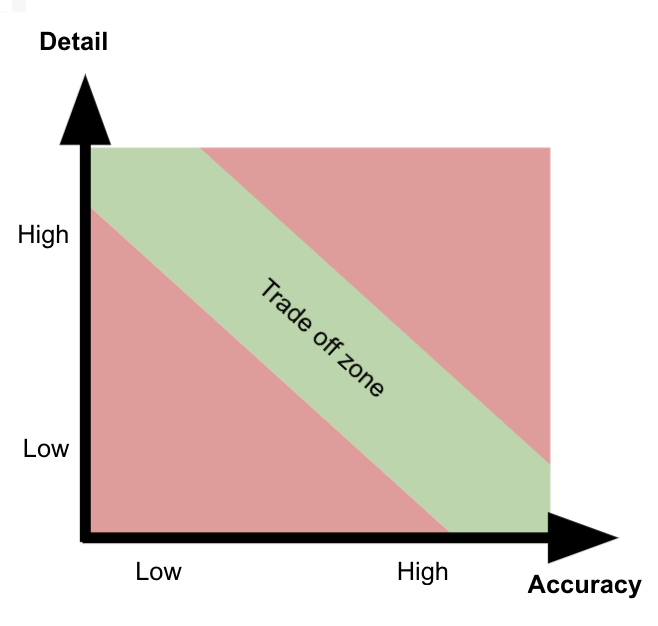Detail vs Accuracy: “It is better to be roughly right than precisely wrong.”
/By Duncan Anderson. To see all blogs click here.
Reading Time: 4 mins
Summary: I normally find there is a tradeoff between detail and accuracy when forecasting the future. To make high quality decisions you want accurate predictions. One key strategy I have to make accurate predictions is to do the hard work to build a simple to understand explanation of the problem space you are considering.
Einstein mental cultivation levels
The levels:
L1: Smart
L2: Intelligent
L3: Brilliant
L4: Genius
L5: Simple
Comment
“If you can't explain it simply, you don't understand it well enough.” - Einstein
“If you can’t explain it to a 6-year-old, you don’t understand it yourself.” - Einstein
You are not born able to talk or do maths etc. You don’t start off smart or dumb, you start off without knowing much of anything!
You don’t start off understanding new concepts, it is cultivated over time. You build concept proficiency to a point where you’re able to explain to others simply. The more you understand, the better you can explain.
Jingle: IMO it is not simple to explain things simply. Something easy to understand (aka put simply) is normally the outcome of hard work.
Detail vs Accuracy - I often find there is a tradeoff when making decisions about the future
Example 1: Financial model for a company
Detail: You do need a full detail financial model that has all of the expenses, eg every subscriptions to software and the pay for each employee.
Accuracy: But when you are making budgeting decisions for the next year it’s simply not possible to have all this detail in your mind at one time. I personally look at 3 revenue scenarios for the business (bull, base and bear) and then ideal spend plans for each division and the 1-2 key variables that each division has. For example productivity per head in sales. From this you can normally make quality tradeoff decisions about who gets what budget.
This can fit on one screen whereas the full financial model is 10,000s of cells.
Example 2: Forecasting completion times for a project
Let’s say 10 people are working on a project with a hard completion date of 6 months away.
Detail: You can build a model that maps all the core tasks and the estimated time for each task to try see if you are under or over resourced. This is likely 1000s of cells in a spreadsheet.
Accuracy: OR you can then reduce this full resolution model into a summary on one page with three scenarios for productivity (bull, base and bear). Under the base case scenario you might be just completing on time. You decide 20% buffer is reasonable so you need to add two people. This can normally be seen on one screen.
A rearticulation:
Accuracy = Not missing the wood for the trees.
Detail = Missing the wood for the trees.
A way to make Simple Accurate Decisions: One Screen Occam's Razor Description
This blog is highly relevant: To solve problems effectively, first build a complete picture of the problem space.
My experience is that building a simple to understand full picture of a problem space is not easy but is crucial.
Working smart = going in the right direction.
Working hard = going fast.
If you are going in the wrong direction it doesn’t matter how fast you are going, you are not making progress.
If you are going in the right direction it doesn’t matter how slow you are going, you are making progress.
My rules of thumb for a simple explanation:
1. It should fit on one screen (be it a doc or a spreadsheet). Synthesising, summarising and simplifying until it fits onto one screen is hard but is worth it.
2. Normally 3-5 variables make up 80%+ of the problem space (link). Find the most important variables and explain them well.
3. Normally the most important 1-2 variables should have a quantitative measure or taxonomy (as well as a qualitative measure and be part of a model :) ).
Comment
However projects are so varied that how you report massively changes.
The Occam’s Razor explanation is the simplest explanation that allows you to make high quality decisions. Too simple = bad. But I normally find that too complex is a far bigger problem.
If you only take away one thing
Simplicity is not simple. Simplicity is the height of making sophisticated (high quality) decisions.
I’ve found it takes a lot of hard work to get things to be easy (simple) to understand. But I’ve found it’s much easier to make high quality decisions when you understand things enough that they are ‘simple’.



